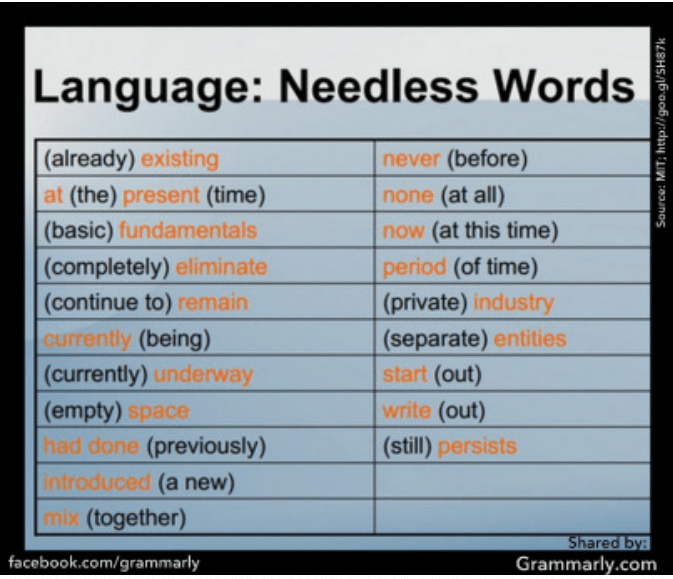I used to abhor the idea of page limits as it applied to paper writing in high school and college. While my peers desperately tried to reach the page limit for a given paper, I fruitlessly attempted not to exceed it. Most students slapped a page of first-rate concocted nonsense on the end of their papers. The more intrepid went to such lengths as to enlarge the periods at the end of sentences to 14-point font (legend has it this can add as much as an extra page to a lengthy paper). Meanwhile, I tried to tweak margins before eventually accepting my role as slayer of sentences.
I was forced to mercilessly cut words and phrases. I deemed the backspace button my foe, a key that existed only to aid in the butchering of my burly, prodigious paragraphs.
Fast forward a few years later, and the same key is no longer an adversary. For a person inclined toward verbosity (guilty), deleting is actually one of the best parts of the editing process, because it helps me eradicate wordiness and irrelevancy and zero in on what’s important.
I’m not fighting against page limits anymore; in fact, I don’t use word count or page length as metrics at all. But I am waging a far tougher, more ruthless battle: the battle for people’s attention. So the question is: what’s important? What’s going to get my blog post read and, conversely, what’s going to hurt my page views and average visit duration?
When you’re writing and/or editing a blog post, what can stay and what can go?
The Chopping Block
Get Rid of:
Needless Words
Prolix paragraphs and wordy sentences fatigue readers. Readers don’t like word fatigue. Kill those sentences swollen with unnecessary adjectives and ballooned with needless words.
Sometimes adjectives and adverbs are unnecessary. Grammarly points out some we can eliminate:
Courtesy of Grammarly
Some others:
“Very unique” (unique already implies something is one of a kind, no need for very, or really or extremely either)
“Unexpected surprise” (surprises are by definition unexpected)
“Exact replica” (a replica is by definition an exact reproduction)
“Completely shocking” (the adjective “shocking” can stand alone without an intensifier)
“Currently exists” (currently is redundant here)
“Still persists” (if something persists, it continues to exist, so no need for still)
“Very [insert adjective here]” (the word “very” is superfluous. Heed Mark Twain’s advice: “substitute ‘damn’ every time you’re inclined to write ‘very;’ your editor will delete it and the writing will be just as it should be.”)
The Word “that”
We don’t need the word “that” as much as we think we do. Some examples:
Research found that people who read books get more sleep at night.
Research found people who read books get more sleep at night.
The chef said that customers loved the new menu items.
The chef said customers loved the new menu items.
Cutting out the word “that” is a small change, and some might argue that it doesn’t make much of a difference. I think it makes for smoother, simpler sentences. Whether or not the word “that” makes sense depends on the sentence, but sometimes, it’s unnecessary.
Sentences Starting with “There is” or “There are”
There are a lot of writers who start sentences like this (ha!). But seriously, consider these two sentences:
There are a lot of people who think Facebook Graph Search is unimpressive.
A lot of people think Facebook Graph Search is unimpressive.
The second sentence is more dynamic and shorter. Sentences beginning with “there is/are” aren’t horrible. (The New York Times uses them.) But when they become ubiquitous within a single blog post, the writing sounds listless and lackluster. And it’s easy to rewrite them.
The Preservation Society
Keep:
Interesting, Relevant Anecdotes
When I first started writing about marketing, I was against including anecdotes (personal and others) in my writing. I likened anecdotes to fluff and frivolity that didn’t offer any real value to readers. And I was completely wrong.
Here’s why: stories affect us physiologically and emotionally. Fast Company refers to two studies that reveal the ability of stories to impact our brains. In one study, researchers discovered readers understand a story by “simulating” events from the story. And tales create a “bonding empathy” that prompts people to identify with a story’s protagonist as if they were that character. It’s why enthralling narratives can draw us into the plot.
Neuroeconomics researcher Paul Zak also talks about the power of storytelling. Zak conducted an experiment in which he had participants listen to a story about a young boy with cancer named Ben and the sadness and anxiety Ben’s father feels. He found when people heard the story, their brains produced two chemicals: cortisol (which is associated with distress) and oxytocin (associated with care and empathy).
Zak then gave individuals the chance to share money with people in the lab. Those who produced both cortisol and oxytocin were more likely to donate money more generously to strangers in the lab. People were paid $20 to be in the experiment; they gave away on average half their earnings.
I’m bordering on wordiness, so in summary: interesting, relevant anecdotes are powerful. In addition to adding a personable feel to a blog post, they can change our brain chemistry. They can even inspire people to take action.
Specific Statistics
If I’m writing a post about how to create shareable content, I need to first prove I have some experience in creating shareable content. Which sentence is more compelling?
My post received 102 Facebook shares and 55 +1s.
My post received a large number of Facebook likes and +1s.
Precise numbers make a big difference. Another example:
Hundreds of people subscribe to my blog.
Three hundred forty eight people subscribe to my blog.
The word “hundreds” is vague. I could say hundreds of people subscribe to my blog when 200 people subscribe to my blog. I could say the same thing if 765 people subscribed to my blog. The latter is more impressive. When people use “thousands” or “hundreds,” I instinctively ask, “how many?”
Fast food places frequently advertise items for “less than a dollar!” when in reality the items cost $0.99. Is this less than a dollar? Technically, yes. But you might as well be paying a dollar.
Nonspecific numbers are dubious, while specific numbers give people proof. They’re also more believable.
Editing in Action
I found that there are a lot of quotes currently out there offering tips on the writing and editing process, but…
Scratch that. This is what I mean:
Quotes offering tips on the writing and editing process abound, but one of my favorites is an easy-to-remember one from Dr. Seuss: “So the writer who breeds more words than he needs is making a chore for the reader who reads.”




